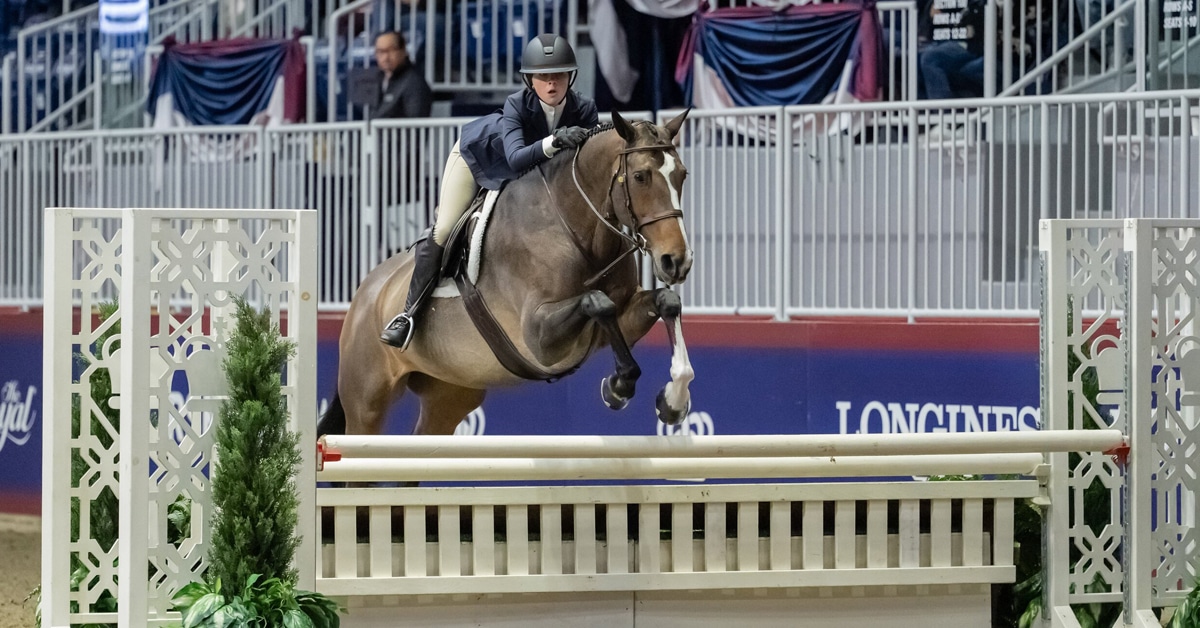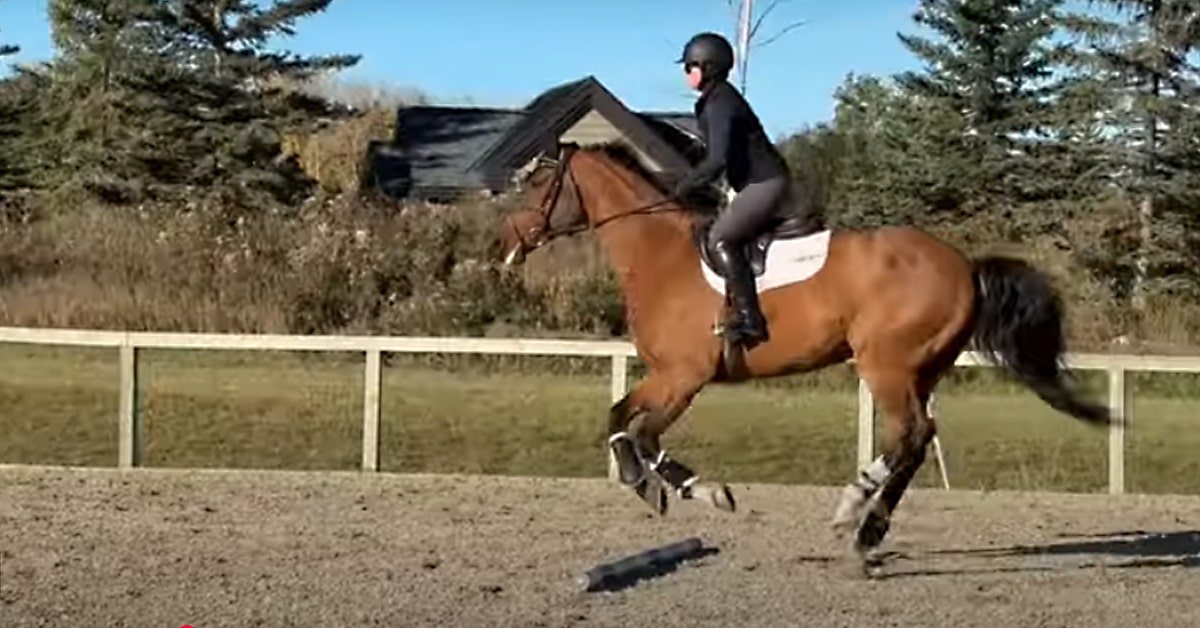It’s been known by many names since it was first identified over 100 years ago: tying-up syndrome, Monday morning disease, azoturia, and most recently, exertional rhabdomyolysis (ER). The last name most accurately describes the problem, as it means the dissolution (breakdown) of muscle cells related to exercise.
Startling Symptoms
Here’s what happens in a typical ER incident: you are exercising your horse, perhaps after he’s had a day or two of rest, or maybe you are trying to introduce your horse to a more intense level of competition with a relatively strenuous schedule. Or it just might be an ordinary day of riding.
Your horse’s normal stride changes to short steps. His movements become stiff. He may eventually stop and refuse to, or seem unable to, move. He may be trembling and is clearly in pain. The muscles of his hindquarters and back are cramping and hard to the touch, and he’s sweating profusely. He’s breathing fast, and if you check his heart rate, it is elevated as well.
In more severe cases, his urine will be a dark, reddish-brown colour, as the kidneys are strained (sometimes to the point where they are damaged) by the need to filter out all the by-products of muscle cell breakdown. The pain can last for several hours, even after he’s finished exercising.
These alarming symptoms can be caused by several underlying conditions, and most are related to the horse’s genetic inheritance. Dr. Stephanie Valberg of Michigan State University’s College of Veterinary Medicine has been studying this condition and explains that the genes involved will vary from one horse to another, but some types are more common with certain breeds. Her research is extremely important, as ER is a surprisingly common condition. “In general, about three percent of horses will develop some type of ER,” says Valberg.
Act Quickly
What should you immediately do if your horse is tying up? “Stop exercising,” says Valberg. This is a crucial first step, as continuing to work the horse will increase his pain and the damage to the muscles. “If you are not close to the barn, arrange to have your horse transported back. Then call your veterinarian.”
Valberg explains that when your veterinarian arrives, he or she will want to make the horse comfortable with tranquilizers and pain relief medication. Next the vet will assess the horse for dehydration and treat that if necessary, and take blood samples for testing to determine the amount of muscle damage (and potentially kidney damage) caused by the incident.
The assessment of the blood sample looks to detect higher-than-normal levels of creatine kinase (CK) and aspartate aminotransferase (AST). These are two proteins normally found in muscle cells; when the muscle cells break down due to ER, the proteins move into the bloodstream and can be detected during the tests. The peak level of CK will be seen about four to six hours after the horse’s ER experience, while AST increases more slowly but stays high longer – as long as seven to 10 days after the episode.
Your veterinarian will then help you develop a plan that will give your horse a chance to rest and heal before beginning a graduated exercise program that in most cases will lead back to full activity.
A Host of Causes
Valberg adds that it is important to know the underlying causes of ER in order to select the most effective treatments. To briefly summarize the different types:
Sporadic ER is experienced by horses with no genetic defects which have been exercised “beyond their conditioning.” It happens when you push your horse too hard or too fast, or when the weather is so hot and humid that the horse can’t cool down. Respiratory infections exhibiting coughs, nasal discharge, etc., also may make the horse more prone to ER; Valberg recommends not exercising the horse at all in these cases. A vitamin E deficiency has also been linked to sporadic ER.
Affected horses should be rested completely for 12 to 48 hours until they can move without signs of stiffness. At that point, they could be turned out into a small paddock or hand-walked with caution. Your veterinarian will help you develop a gradual course of conditioning.
Recurrent ER is linked to an abnormality in intracellular calcium regulation, which is probably inherited. Valberg and her colleagues are currently working to identify the genes involved. Horses with this condition seem more likely to tie up if they are overly excited; Valberg recommends that those affected should be kept in stalls in the quietest area of the barn. Plenty of pasture time helps them work off any excess energy and they should have some exercise every day (no lay-off days).
Chronic ER occurs when the horse has an underlying condition making him or her more prone to this problem, suffering repeated episodes of ER accompanied by increased muscle enzyme activity, even with very mild exertion. It can be caused by:
• Polysaccharide Storage Myopathy type 1 (PSSM1). A genetic mutation most common among Quarter Horses, Paints, Percherons, and Belgians causes an abnormality in the way some starches are stored in the muscle cells. Even if horses have this mutation, appropriate feeding (avoiding sweet, starchy foods and providing more calories through fat and protein) and a daily exercise routine can prevent ER from developing.
• Polysaccharide Storage Myopathy type 2 (PSSM2) While the horse has the same symptoms and similar results when muscle cells are tested, the genetic mutation seen in type 1 is not present. This type is common in Quarter Horses, and is also seen in Warmbloods, Arabs, Thoroughbreds, and Standardbreds.
• Myofibrillar myopathy (MFM) is a muscle disorder found mainly in Arabian and Warmblood breeds and is a subset of PSSM2. It is believed that horses with MFM have an underlying abnormality in the cytoskeleton and contractile proteins, causing gaps where the contractile proteins break that become filled with glycogen, giving the false appearance of a glycogen storage disease. Symptoms include extreme fatigue, muscle hardness, hind end muscle tightness, inability to hold self-carriage, and shifting lameness.
• Malignant hyperthermia (MH) is a life-threatening pharmaco-genetic disease of skeletal muscle elicited by exposure to anesthetics such as halothane, muscle relaxants such as succinylcholine, and stress. Gene mutations cause dysfunction in skeletal muscle, resulting in excessive release of calcium into the contractile portion of muscle tissue causing intense heat, excessive carbon dioxide in the bloodstream, lactic acidosis, and even death. There is no apparent breed, gender, or age predisposition.
With careful feeding and a good plan for exercise, Valberg estimates that about 70% of horses with chronic ER types will be able to lead normal lives and even be competitive. Many horses with the genetic tendency never or rarely experience tying up if they are conditioned slowly and fed appropriately.
Valberg adds that there are companies offering genetic testing for these and other genetic diseases when there is no known gene associated with the disease. “They offer no scientific publications to validate what they are testing for,” she warns. She recommends arranging for any testing through your veterinarian, so you can be sure the results are meaningful.
Valberg is encouraged by the results of recent decades of studying this painful and potentially very serious condition, and says that ongoing research should lead to better ways to identify and treat the underlying issues that cause some horses to experience ER. Horse owners may be able to contribute to this ongoing research by submitting biopsied muscle tissues from their animals. Go to cvm.msu.edu/research/faculty-research/valberg-laboratory/exertional-rhabdomyolysis for more information about what they are looking for and how to send a sample.
The Latest









